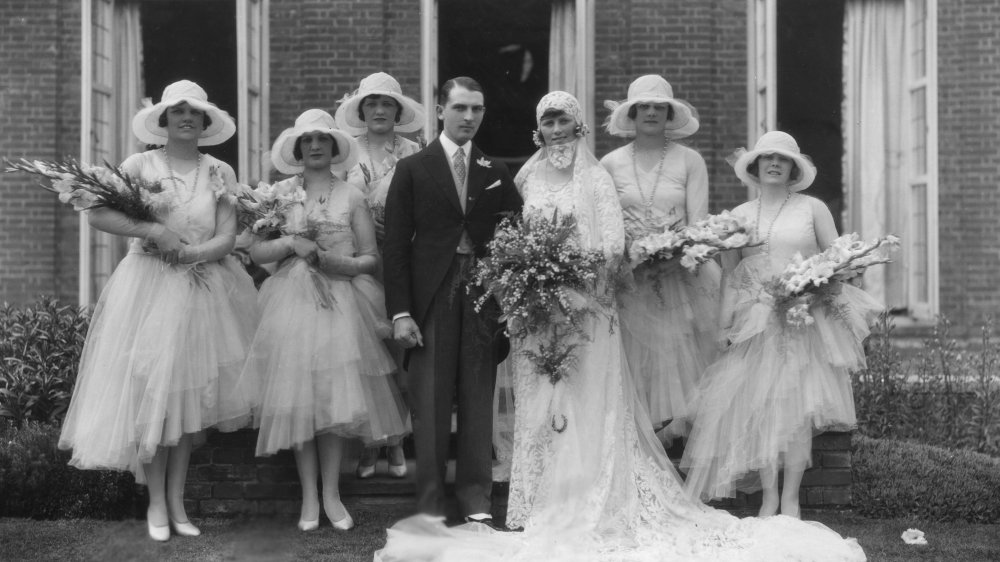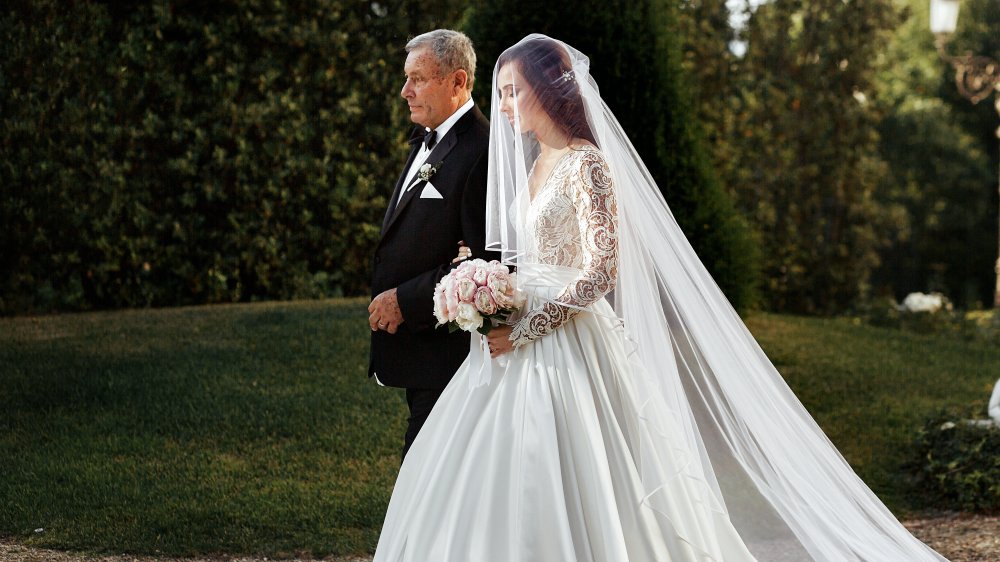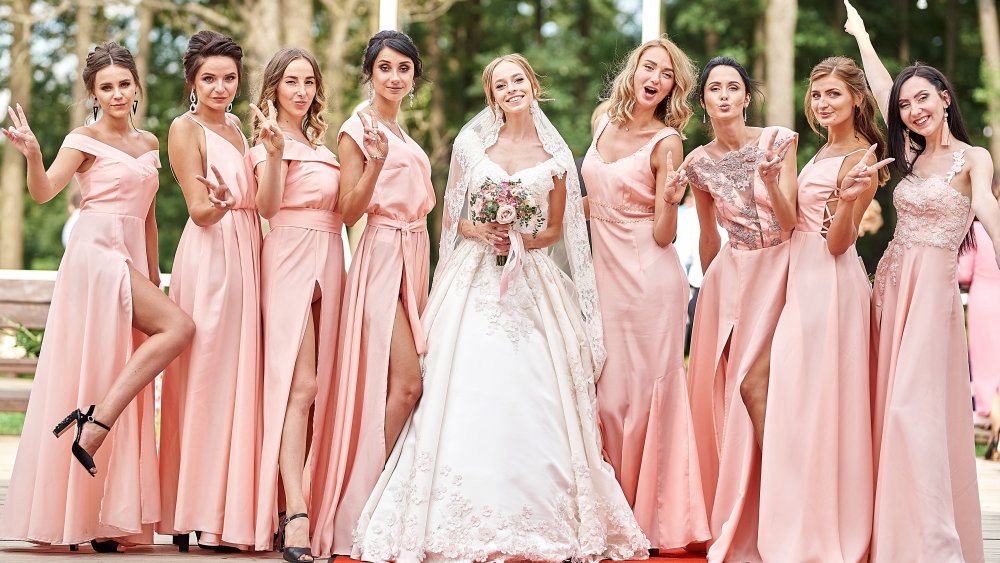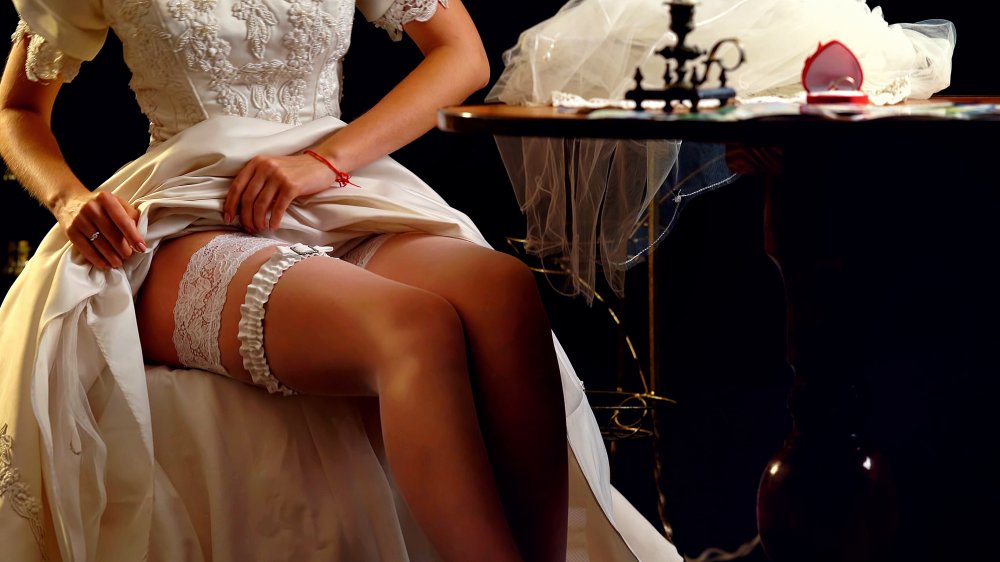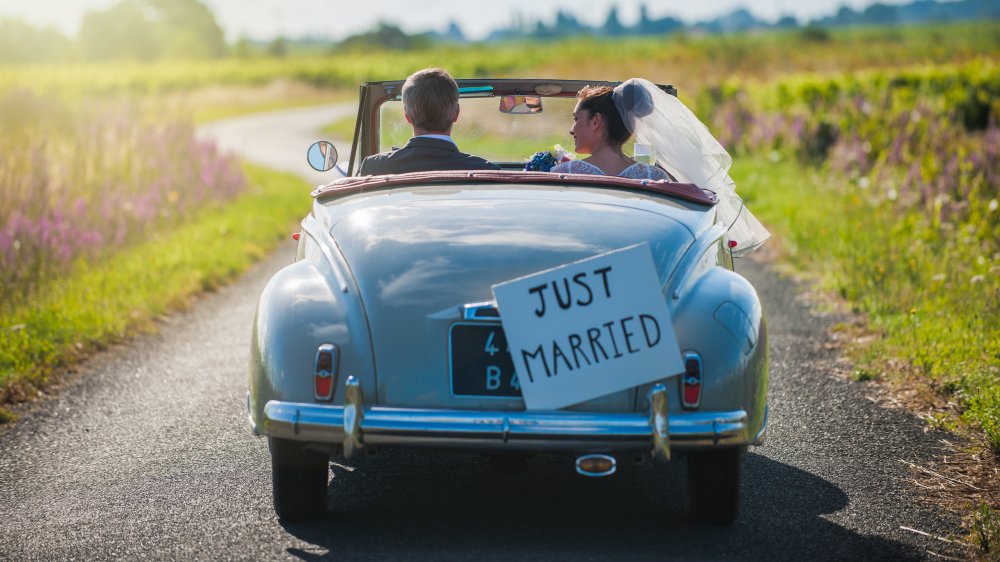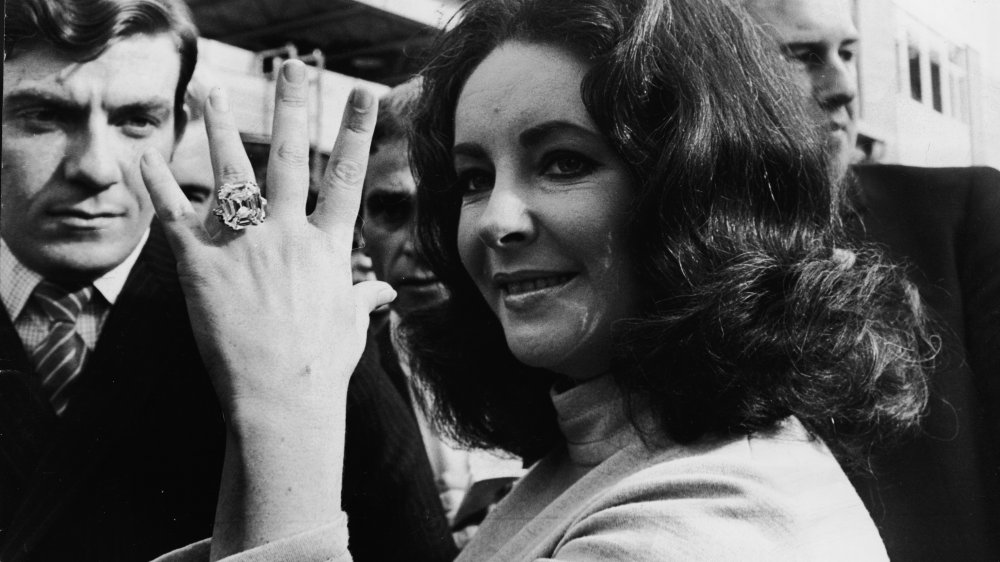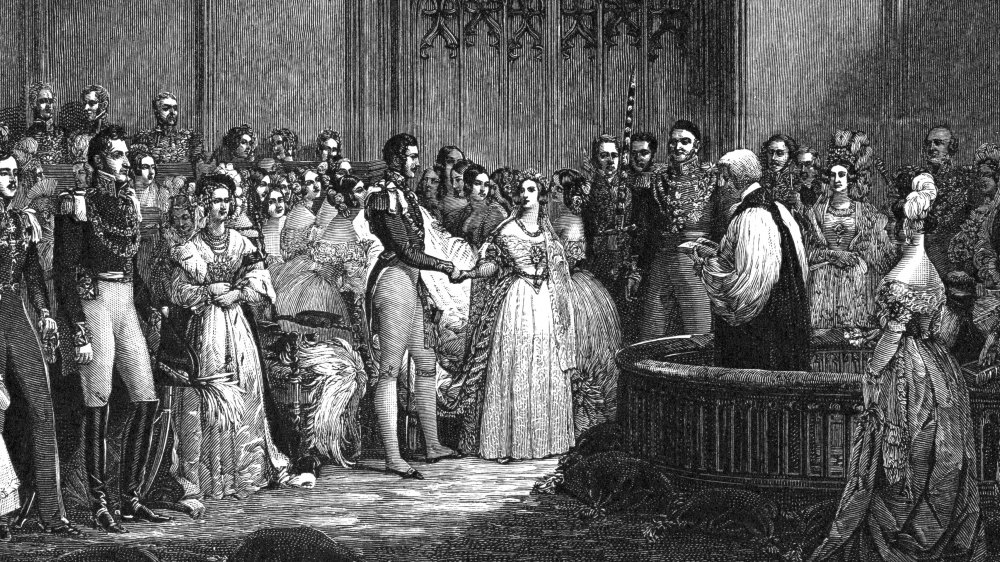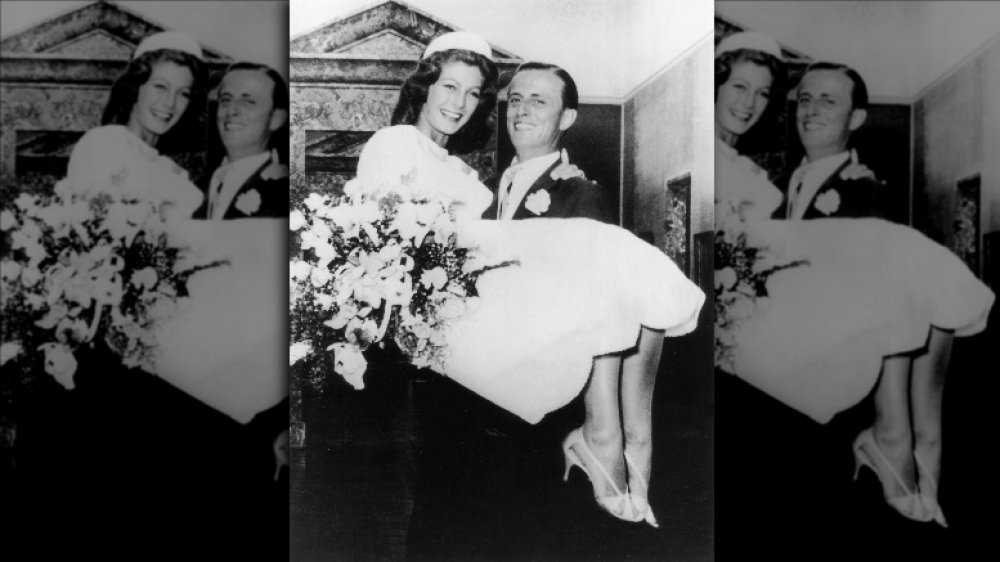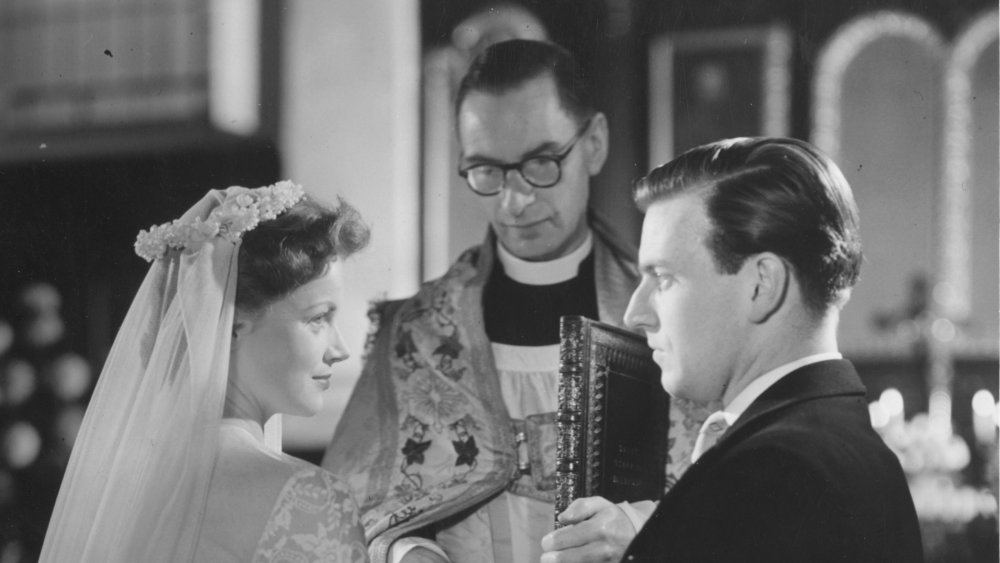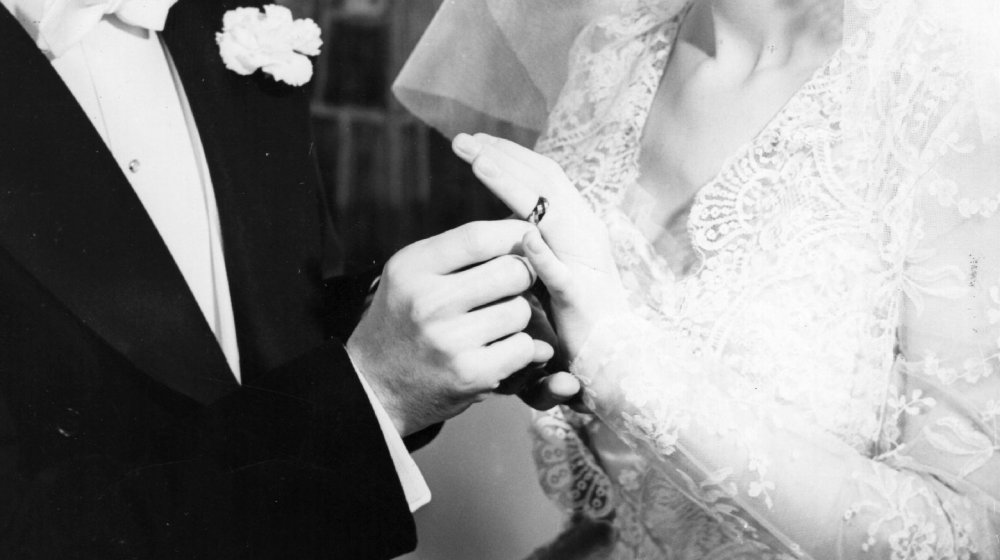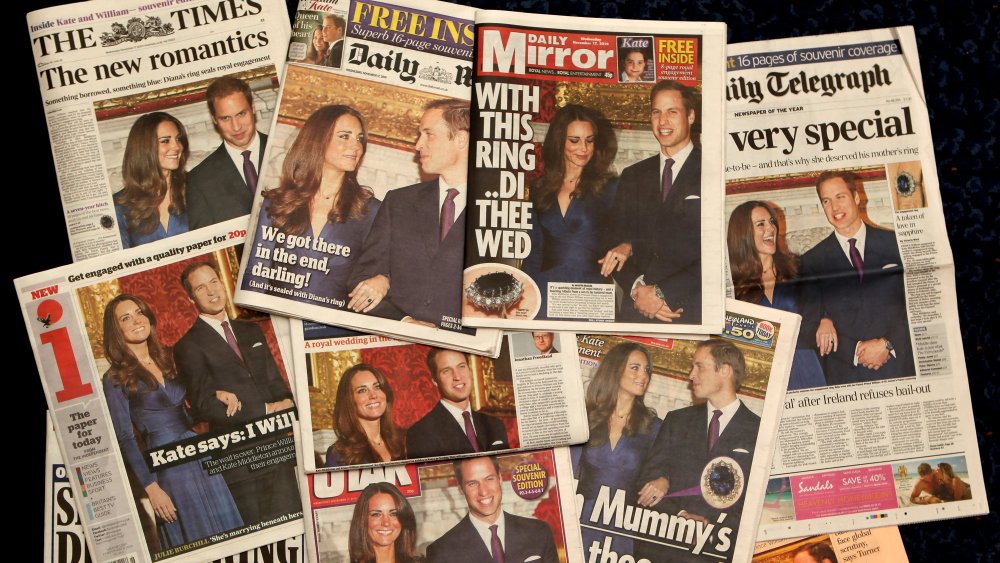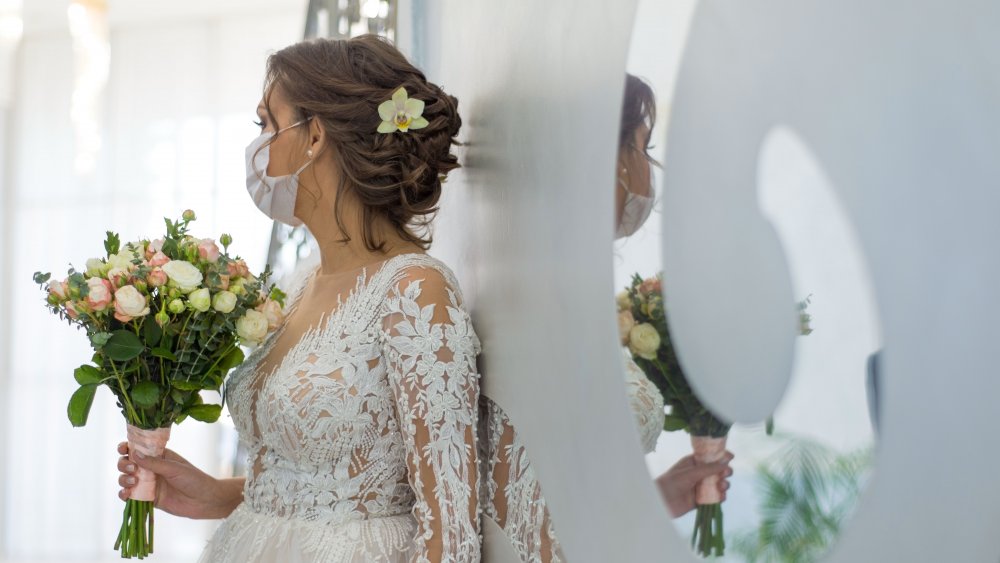Popular Wedding Traditions With Creepy Origins
Human beings have been roaming this planet for a long time, inventing things, and creating civilization. Along the way, we came up with the concept of the "tradition," something that's done in a similar way over and over again mainly because the folks who came before us did it that way. And nothing is stuffed with more traditions than your typical wedding.
The funny thing about traditions, of course, is that their origins are often lost over the course of time. Even after we forget why we're doing something, societal pressure takes over and keeps the tradition going. After a few decades or centuries, all the serial numbers get filed off and we're left with a weightless tradition that exists in a weird vacuum: We do it because our parents did it, and they did it for the same reason.
No other human experience is as tradition-laden as the wedding ceremony — and few traditions are as removed from their origins. Why do grooms have a best man? Why do brides wear veils? Why in the world do we have the whole ridiculously creepy garter business? Once you start digging into the reasons, it quickly becomes clear these are popular wedding traditions with creepy origins. How creepy? Let's take a closer look.
Fathers giving away the bride to protect their assets
It's a powerfully emotional part of the wedding ceremony when a proud father walks his daughter down the aisle and then leaves her in the care of her soon-to-be husband. Today, this tradition is usually seen as simply a beautiful moment between a dad and his daughter, and a way to honor the father's role.
The creepy reason behind this tradition makes some modern brides rethink its inclusion, however. It might (not) shock you to learn that there was a time when women were considered to be more or less property, and weddings were more like negotiations than love affairs. Although Marriage Customs of the World author George Monger says that literal sales of brides weren't very common, he notes that most marriages were negotiated as business deals between the fathers of the groom and bride well before the ceremony.
As historian Susan Waggoner explains, unmarried daughters were considered a financial liability at a time in history when women were forbidden from pursuing many professions. The father walked his daughter to the groom in order to stay close just in case the groom and his family tried to back out of the deal. If that makes a wedding seem about as romantic as selling a used car, well, you're not wrong.
The best man is really backup
The role of the best man typically goes to a brother or close friend, the guy you have always relied on to have your back. In contemporary times, it's a big honor that basically comes with one responsibility: Planning the bachelor party.
The creepy origins of this tradition go back to a time when women were considered property. Property you had to pay for — or steal.
As Reader's Digest explains, the practice of kidnapping a girl in order to marry her (as opposed to negotiating with her father) was known as marriage by capture and it wasn't uncommon. As you might imagine, this often led to an angry family tracking down the groom with violent intentions. As a result, it was the wise groom who brought some backup — namely his groomsmen — just in case a brawl broke out. The best man was literally the guy who was best at fighting.
According to Country Living, the presence of the groomsmen and best man was also to ensure that the bride — who, we might remind you, was literally kidnapped in this scenario — didn't make a break for it herself. This is why the best man stands up there next to the groom. If a fight's going to break out, you need your best fighter right there, ready to go. Or to tackle a runaway bride.
Bridesmaids and those dresses they can totally wear again
When you think about it, your typical wedding requires a lot of manpower. Aside from the caterers, bartenders, ministers, and other employees, there are the groomsmen and the bridesmaids. It's literally an army of people dispatched to organize a single ceremony and party.
These days, the main thing bridesmaids have to worry about is whether or not the dress they're forced to wear is hideous. But back in the day, they had a lot more to worry about — because they were essentially decoys meant to draw danger away from the bride.
There's some disagreement as to the nature of that danger. Author Ellen Bell suggests that, centuries ago, bridesmaids were once brought along to the wedding in order to draw evil spirits away from the bride. Reader's Digest notes it might have been to confuse rival lovers or even criminals seeking to kidnap the bride — dating back to Ancient Rome and feudal China. The idea is obvious: Have a bunch of women dressed in similar outfits and anyone seeking to abduct the bride will have a heck of a time deciding which one to grab. Per Racked, the tradition of bridesmaids wearing dresses identical to the bride's persisted until the 1880s.
Of course, modern bridesmaids who consider the role less of an honor than a job with a terrible uniform should consider something else noted by Reader's Digest: In ancient times, the bridesmaids were literally the bride's maids. At least these days you usually get a gift for your work.
The creepiest tradition: The garter
Anyone who has ever attended a wedding knows that the real weirdness starts about halfway through. And nothing is creepier, or weirder, than the tradition of the garter.
You know the drill: After the bouquet is thrown and caught, the groom sits his bride down and makes a big show of removing a garter from her thigh (sometimes making everyone uncomfortable by being "sexy" and using his teeth). Then he tosses the garter into a crowd of the single men in attendance, and, sometimes, whoever catches it puts the garter on the woman who caught the bouquet. At some parties, every inch above the knee is supposed to grant the happy couple a year of happiness.
It's all obviously focused on inspiring more people to get hitched, but as The Knot reports, its origins are super creepy. Back in the day couples were expected to consummate the marriage immediately, and proof had to be supplied. The groom often tossed the bride's underthings out to prove they'd done the deed.
A slightly less creepy but still disturbing origin offered by wedding expert Kim Forrest is the tendency of wedding guests to tear off pieces of the bride's clothing for good luck charms. The garter was offered up to stop them from ripping everything off of the poor woman.
Honeymoons: you've got to hide your love away
You might think that the origin of one wedding tradition is pretty obvious. After all, the whole point of a honeymoon seems like the sort of ancient and primal aspect of human relationships that probably hasn't changed that much over the centuries.
But the origins of the traditional trip that newlyweds go on after tying the knot is just as creepy as ... well, honestly, every other tradition associated with the modern wedding. And it all goes back to "wedding by capture," the wholesome tradition of grooms kidnapping their brides and forcibly marrying them. As wedding historian Susan Waggoner explains, these kidnappings often inspired a bride's family or tribe to pursue her, and the groom would hide her away until he managed to get her pregnant.
While some historians dispute this explanation, The New York Times notes that "honeymoon" may be derived from the Norse word "hjunottsmanathr," which literally means "go into hiding." It's also possible that the term might even come from the 16th century, originating in the Babylonian practice of giving newlyweds a month's supply of honey wine and sending them away for an entire moon cycle to encourage conception.
Diamonds: the long con
The diamond engagement ring is one of the mainstays of the wedding tradition. Even people who eschew many of the hoary old traditions will usually still indulge in a diamond ring. After all, spending some serious money on a rare gem is an obvious symbol of your devotion.
Except, of course, as the Atlantic notes, diamonds aren't actually all that rare. And shouldn't really be as valuable as they are. They are actually a relatively recent addition to the wedding tradition. In other words, the diamond ring might be the creepiest of all creepy wedding traditions, because it's been basically incepted into our brains by an (admittedly brilliant) advertising campaign.
Basically, in the late 19th century, the discovery of new diamond mines flooded the market with diamonds, dropping their price. With demand sluggish and supply out of control, the De Beers family hired an ad agency, N.W. Ayer, to reinvigorate the market. Their solution was to link diamonds with weddings — and insinuate that if a groom didn't give their bride-to-be a whopper of a diamond, they were failures.
The campaign was subtle. Celebrities were shown flaunting their diamond wedding rings, news stories were planted about them, and stories were written about socialites that just happened to mention their rings. Sales jumped from $23 million in 1939 to $2.1 billion in 1979. Diamonds aren't really forever (they can, in fact, be damaged or destroyed), but good marketing certainly seems to be.
The veil: building a mystery
For a lot of brides, the veil is an optional bit of style in the modern wedding. After all, how often will you get the chance to wear a veil in public without people thinking you're crazy? Might as well take advantage of your sartorial opportunities when they present themselves.
Of course, as Martha Stewart notes, the veil has a fairly obvious religious connection to modesty and purity. Brides wear veils to project a modest attitude and avoid inflaming the passions of the men around them with, you know, an exposed cheekbone. Back in ancient Rome, veils were also used to ward off evil spirits.
But wedding expert Susan Waggoner points out another origin of this tradition, dating back to the days when arranged marriages were much more common around the globe. When the marriage was arranged by the fathers and negotiated like a business deal, love and physical attraction were secondary notions. The veil often served to keep the bride's appearance secret until it was too late for the groom to have second thoughts about who he'd just agreed to spend the rest of his life with. Waggoner explains that Queen Victoria was the first modern monarch to be married in a veil and set the trend for modern brides.
Over the threshold, like it or not
There really isn't a wedding-related tradition that doesn't stem from a really creepy place, mostly having to do with the fact that ancient weddings were, apparently, commonly little more than kidnappings. As HowStuffWorks points out, even the bride and groom leaving the wedding reception before everyone else has to do with the kidnapping theme, as it symbolizes the groom stealing the bride away from her family. Even one of the silliest and most romantic-seeming gestures, the groom carrying the bride over the threshold of their home, is steeped in creepiness once you dig into it.
As author George Monger writes, the whole threshold thing is designed to give plausible deniability to the bride, who is supposed to be virginal and reluctant to lose that status. By carrying her over the threshold, she can maintain a thin veneer of reluctance even if she's just as eager to get inside as the groom is.
There are a few other factors, including good old-fashioned superstition. Carrying the bride means she can't trip when she enters her house for the first time, which would be bad news, and, as Henry Morley warned in 1890, saves her from any spells that have been laid on the entrance. Obviously the past was a much more interesting — if more prudish — time.
You may now kiss the bride ... and possibly the priest
It's a standard part of the script that you hear every time a TV show or movie features a wedding: "You may now kiss the bride!" Cue applause, run credits.
This might seem like a simple, romantic confirmation of the newly-established union between two lovers — it's no longer forbidden to make out with your new spouse! Or it might seem like a signal that the stuffy religious ceremony is over, and it's time to celebrate. The actual origins of this classic tradition are a little creepier.
As author Christopher Lee notes, this began as a traditional kiss of peace that the presiding priest would lay on the groom. The idea was that the priest would convey a blessing to the groom, and then invite the groom to pass that blessing on to the bride, sort of like an electrical charge. That's why it's traditionally the groom being told he can kiss the bride and not the other way around.
While it might seem weird, the kiss of peace was part of ancient Christianity from the very beginning. It remains part of the liturgy today — though as America Magazine notes, it's more commonly called the "sign of peace" today, and is usually a handshake.
Keep those wedding ring receipts
Even the least traditional wedding usually involves an exchange of rings. The wedding ring is such a fundamental symbol, it's often used as a visual shorthand for a wedding ceremony. And it's a piece of jewelry that instantly tells you something really important about a person: with just a glance at their hand, you know whether they're married or not.
As author Vicki Howard notes, it's hard to generalize about the custom of rings as a part of religious wedding ceremonies across cultures. However, they were firmly established as part of the wedding tradition in Rome in the 15th and 16th centuries. Rather than simply symbols of eternal devotion, however, the wedding ring also had a creepy origin: It was sometimes used as a deposit on the expected dowry, or a simple payment to the bride as part of her acquisition.
In fact, author Karen K. Hersch notes that rings were often used for this purpose in regular business transactions in Rome, making it very possible they entered the wedding ceremony for that very purpose. The groom would offer a ring as a sign of his serious intention, offering up some collateral that the bride could keep if he decided to back out of the engagement.
Wedding announcements were fraud prevention
Most people are pretty happy when they get married. It's generally considered an occasion to celebrate — most people throw a pretty rockin' party to mark the occasion, after all. So it's pretty natural to announce your wedding to the world. For people in "society," this might involve a profile in a newspaper, but even regular folks often announce their wedding in a church bulletin or local news outlet. The creepy reason we do this is lost to time: It was fraud prevention, essentially.
As Simply Catholic reports, up until the Middle Ages, there was really no requirement to make your wedding public or to even involve the Church. People could get married in private, even without witnesses. This led to a small problem where people would conceal previous marriages if they were inconvenient and simply get married again.
The Church's solution to the problem came with the Fourth Lateran Council, which required the publishing of Banns of Marriage. This was a public announcement listing everyone involved and was designed to give anyone who knew about previous marriages a chance to speak up. These days the part where the priest asks if anyone has an objection to "speak now" is the modern, slightly less onerous version of this. Still, the public announcement became a tradition as a result.
A bridal bouquet keeps the plague away
A bouquet of flowers has been associated with weddings for a very long time. As author Carley Roney notes, the tradition dates back to ancient Greece. Brides back then carried bouquets of flowers to ward off evil spirits that might try to harm her. Which probably explains how the bouquet got repurposed to protect brides from another invisible threat.
As we're all finding out, a global pandemic can make you do some crazy things. Today, we're hoarding toilet paper and hand sanitizer. As The New York Times reports, back in the Middle Ages, people believed that bad smells carried contagion, and so they would carry around flowers and bags of spices or scented handkerchiefs to breathe through. Although the origin of the classic rhyme '"Ring Around the Rosy / Pocketful of Posies" actually has nothing to do with the plague, the reason we think it does is that people actually did carry posies around to sanitize the air.
And, unhappily, this is probably where the tradition of the bridal bouquet came from. As HowStuffWorks notes, during the bubonic plague (aka the Black Death), brides probably carried stinky stuff like garlic or dill in a desperate attempt to scare off whatever was causing the disease (germ theory being a few centuries from general acceptance). Over time, the bouquet became cemented as part of the tradition, but the stinky stuff was replaced by better-smelling flowers.
